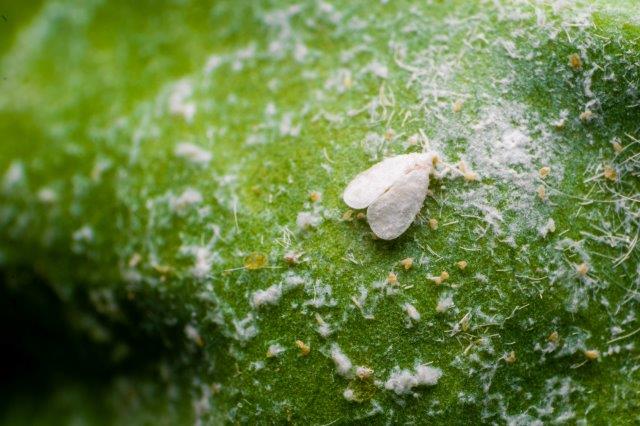Whiteflies are a short-lived tropical and subtropical insect found in the warmest regions throughout the world where they indiscriminately feed on any plant requiring year round warmth and humidity.
In cold regions where they could not possibly overwinter, whiteflies are notoriously known to infest indoor houseplants and greenhouses to stay protected from outdoor conditions. Whiteflies are not choosy and known to infest more than 250 greenhouse staples including tomato, cucumber, bean, hibiscus, orchid, and citrus.
Similar to aphids and mites, whiteflies are sap-sucking insects that feed on the nutrients of a host plant rather than eating the plant and foliage directly like much larger garden pests. Although whitefly infestations can be a nuisance, they are soft-bodied insects able to be eradicated in minutes.
How to Get Rid of Whiteflies
- Whitefly Distribution: Greenhouses and both tropical and sub-tropical climates around the world
- Whitefly Host Plants: Nearly any greenhouse crop such as flowers, fruits, vegetables, fruiting trees
- Whitefly Damage: Curled, yellow-spotted leaves and stunted new growth
- Whitefly Life Cycle: 30-40 days
- Whitefly Eggs Per Lifetime: ~400
- Whitefly Control: 70% isoprpyl alcohol, pruning, neem oil, dish soap spray, high pressure hose
- Whitefly Predators: Ladybug, wasps, lacewing, spiders
- Most Common Whitefly in North America: Greenhouse Whitefly (Trialeurodes vaporariorum)

What Do Whiteflies Look Like?
Immature whiteflies can be inconspicuous and difficult to identify because they change appearance 5 times throughout their brief lifecycle before reaching adult stage. Newly hatched larval instar whiteflies (nymphs) are translucent, round, wingless, and look closer to a scale insect than a mature whitefly.
After about 8-15 days, whitefly nymphs become fully developed and will express their adult features. Adult whiteflies are oblong, thin, pale yellow, and have an easily identifiable large set of white-colored wings, similar in appearance to thrips.
Species of whitefly that are multi-colored and have striped or patterned wings are generally not a pest.
Whitefly Damage

Whiteflies are a sap-sucking nuisance to both indoor plants and the outdoor garden. Just like aphids and spider mites, whiteflies feed on the essential sugary nutrients within a leaf while leaving behind the more fibrous midrib and veins.
Signs of whitefly damage on leaves can appear very similar to other sap-sucking pests: yellowing, browning, curling, early decline. Whiteflies are generally easy to spot early on prior to a problematic infestation.
The effects from a few solitary whiteflies feeding on a host is often too negligible for the plant to be bothered, but an entire host can quickly drain a plant of its sap. Plants are also susceptible to pathogens and diseases entering the vascular system from aggressive feeding.
What Do Whiteflies Eat?
Whiteflies are notoriously found in greenhouses and indoor houseplants across the world and are not choosy as to what they feed on.
Whiteflies have been found to prefer more than 250 different species of ornamental flowers, fruits, vegetables, and trees commonly grown in the greenhouse including tomato, cucumber, bean, hibiscus, aster, and orchids.
The second most pervasive species of whitefly in the country known as sweet potato whitefly has a far more extensive diet including watermelon, eggplant, pepper, squash, and nearly all brassicas. And like other smaller pests, whiteflies are sap-sucking and do not eat any foliage or leaf directly.
Whiteflies Eggs
Without the presence of adult whiteflies nearby, whitefly eggs can be almost impossible to detect because they are extremely small, difficult to spot with the naked eye, and only remain eggs for 2-4 days before hatching.
Like many garden pests, the whitefly will lay its eggs on the underside of leaves for protection. Most species of whitefly lay eggs that are excessively small, perfectly rounded, pale yellow, and lack any patterning.
Some species such as the giant whitefly and spiraling whitefly will lay a very distinct spiraling pattern of eggs on the underside of leaves. Adult whiteflies can lay up to 400 eggs in their short 30-40 day lifecycle.

How To Get Rid of Whiteflies
Whiteflies are a delicate and soft-bodied insect able to be easily sprayed off with a high pressure hose. Infested houseplants can be brought outside and completely eradicated of eggs, larvae, and adults in under a minute if using a high pressure hose.
Another popular method is to purchase a store-bought whitefly sticky trap which can be hung immediately near any problematic areas in the garden or home.
Whitefly infestations may also be treated by creating a solution spray by adding a tablespoon or so of either castile soap, dish soap, or 70% isopropyl alcohol to about a liter of water. Spray as needed throughout the season.
Whitefly Treatment

- 70% Isopropyl Alcohol - Lightly apply undiluted alcohol with a cotten swab or spray bottle
- Pyrethrin Spray - Natural chemical extract and pesticide from the genus Chrysanthemum
- Organic Neem Oil Spray - 1 tsp neem oil and 1/4 tsp dish soap to 1 quart water
- Imidacloprid-based Spray - Commercial pesticide popularly used for hardshell pests
- Dish Soap and Water - 2 tbsp to 1 quart water
- High Pressure Hose - Many insecticides are sold to be attached to the end of any common gardening hose for immediate control




